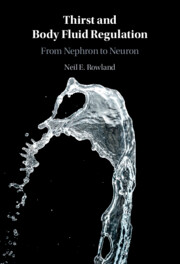Book contents
- Thirst and Body Fluid Regulation
- Thirst and Body Fluid Regulation
- Copyright page
- Contents
- Figures
- Preface
- 1 Fundamentals of Thirst and Body Fluid Regulation
- 2 Body Fluid Compartments, Inputs, and Outputs
- 3 Intracellular Dehydration Thirst and Drinking
- 4 Intracellular Dehydration: Mechanism
- 5 Extracellular Dehydration Thirst and Drinking
- 6 Pregnancy and the Ontogeny of Thirst
- 7 Food-Associated Drinking and Nycthemeral Rhythms
- 8 Hybrid Dehydrations: Water Deprivation
- 9 Hybrid Dehydrations: Thermal Stress and Exercise
- 10 Thirst in Aging and Clinical Populations
- 11 Comparative Aspects of Body Fluid Regulation
- Appendix Methods in Physiology and Neuroscience
- References
- Index
6 - Pregnancy and the Ontogeny of Thirst
Published online by Cambridge University Press: 09 December 2021
- Thirst and Body Fluid Regulation
- Thirst and Body Fluid Regulation
- Copyright page
- Contents
- Figures
- Preface
- 1 Fundamentals of Thirst and Body Fluid Regulation
- 2 Body Fluid Compartments, Inputs, and Outputs
- 3 Intracellular Dehydration Thirst and Drinking
- 4 Intracellular Dehydration: Mechanism
- 5 Extracellular Dehydration Thirst and Drinking
- 6 Pregnancy and the Ontogeny of Thirst
- 7 Food-Associated Drinking and Nycthemeral Rhythms
- 8 Hybrid Dehydrations: Water Deprivation
- 9 Hybrid Dehydrations: Thermal Stress and Exercise
- 10 Thirst in Aging and Clinical Populations
- 11 Comparative Aspects of Body Fluid Regulation
- Appendix Methods in Physiology and Neuroscience
- References
- Index
Summary
During pregnancy in humans and rats, plasma osmolality is regulated at a level about 3% lower than in nonpregnant females (or males). This may be, in part, caused by reproduction-related hormonal changes. Late in gestation, fetal sheep show acute swallowing responses to some dipsogens, and the relevant CVOs in the brain appear to have full responsiveness to those dipsogens at this time. Postnatal development of independent drinking in rats shows that responses to hypovolemia are present and vigorous very soon after birth, whereas development of osmoregulatory drinking has a considerably slower ontogenetic trajectory. Further, this trajectory seems to be slower in mice than rats and requires further study. Some aspects of osmoregulatory drinking in rats, as well as food-associated drinking, appear to have an experiential component. Hypovolemia or other circulatory challenges before birth in rats cause alterations in the ontogenetic trajectory of drinking, although the limits and mechanisms of this phenotypic plasticity have not been fully elucidated.
Keywords
- Type
- Chapter
- Information
- Thirst and Body Fluid RegulationFrom Nephron to Neuron, pp. 97 - 116Publisher: Cambridge University PressPrint publication year: 2021

